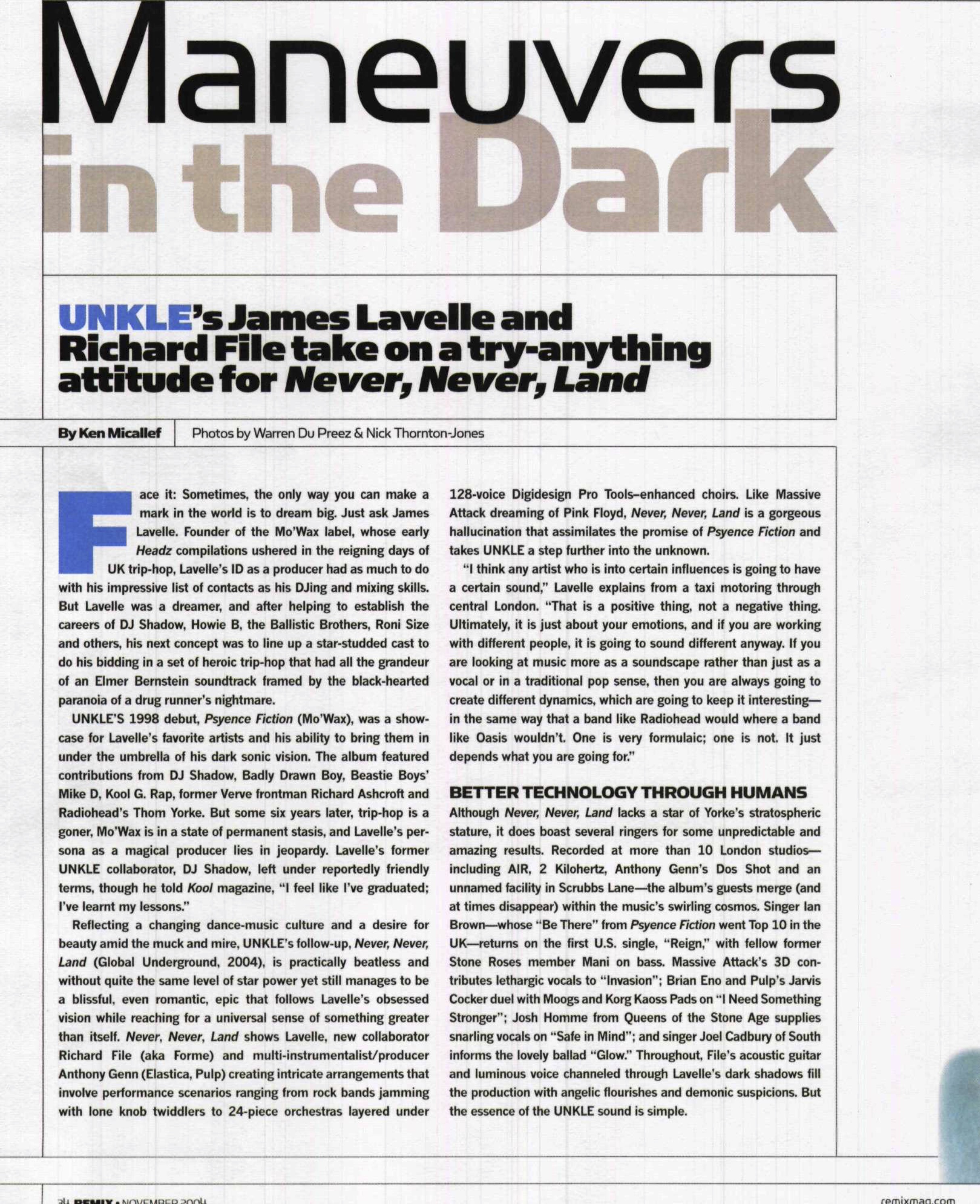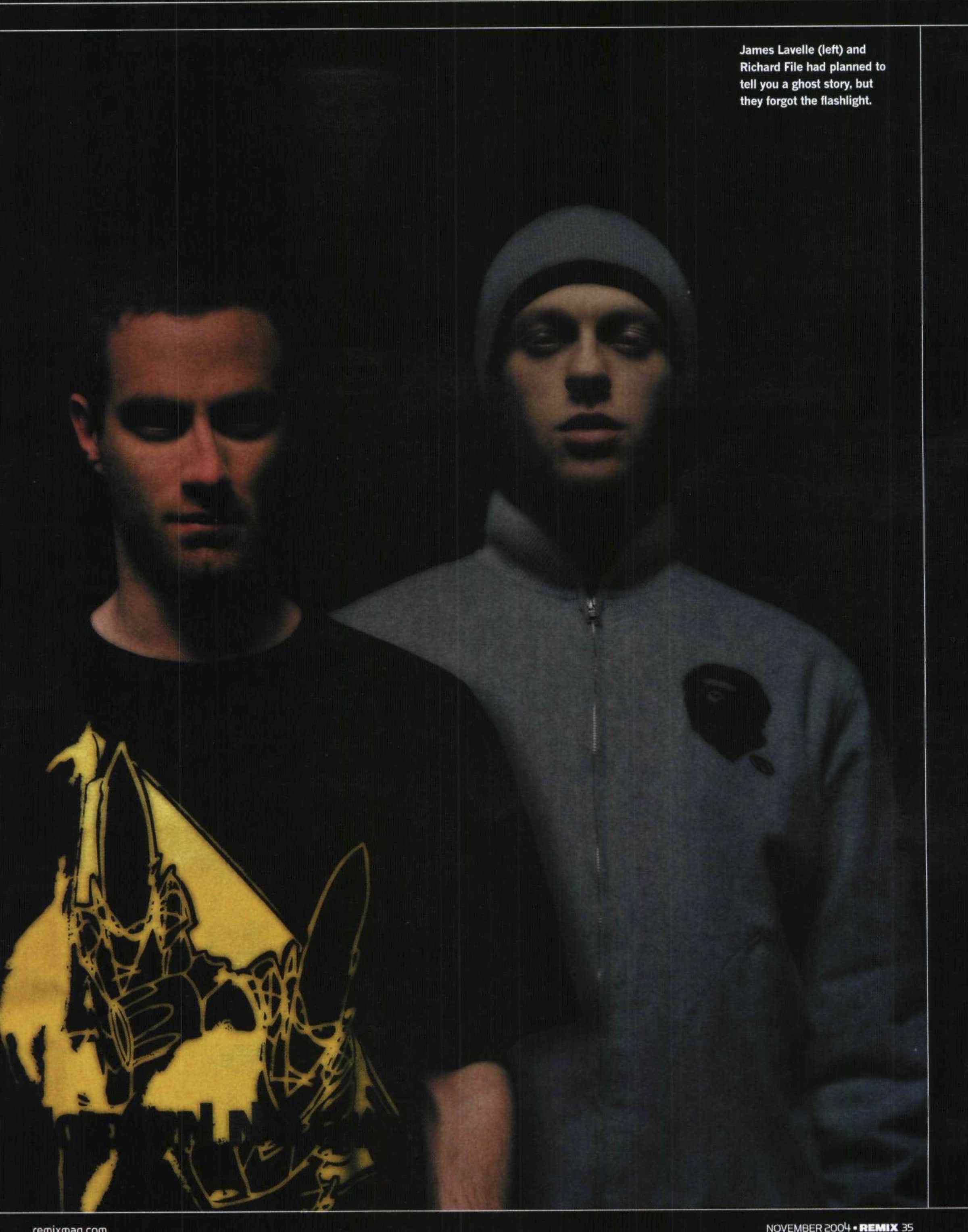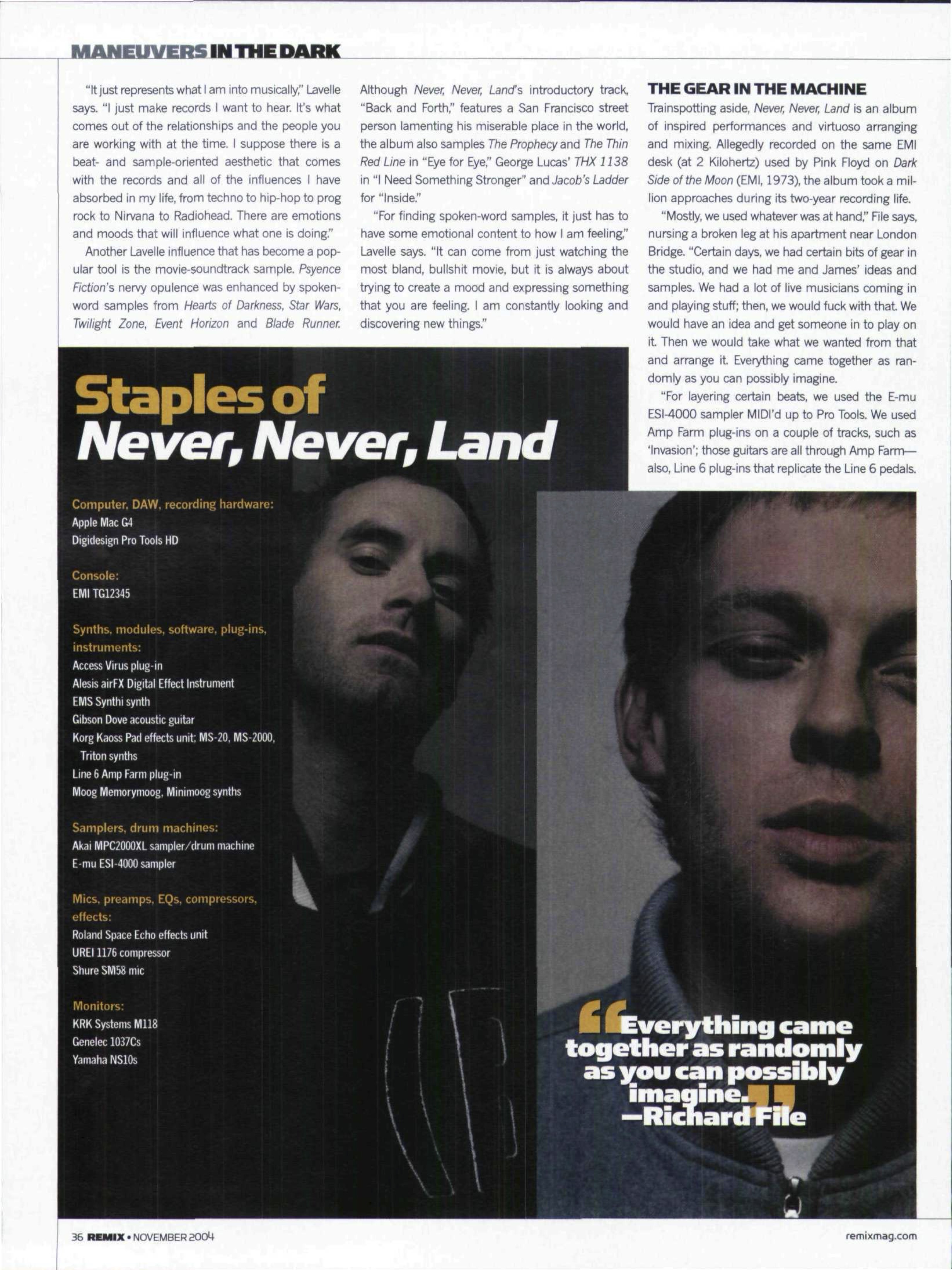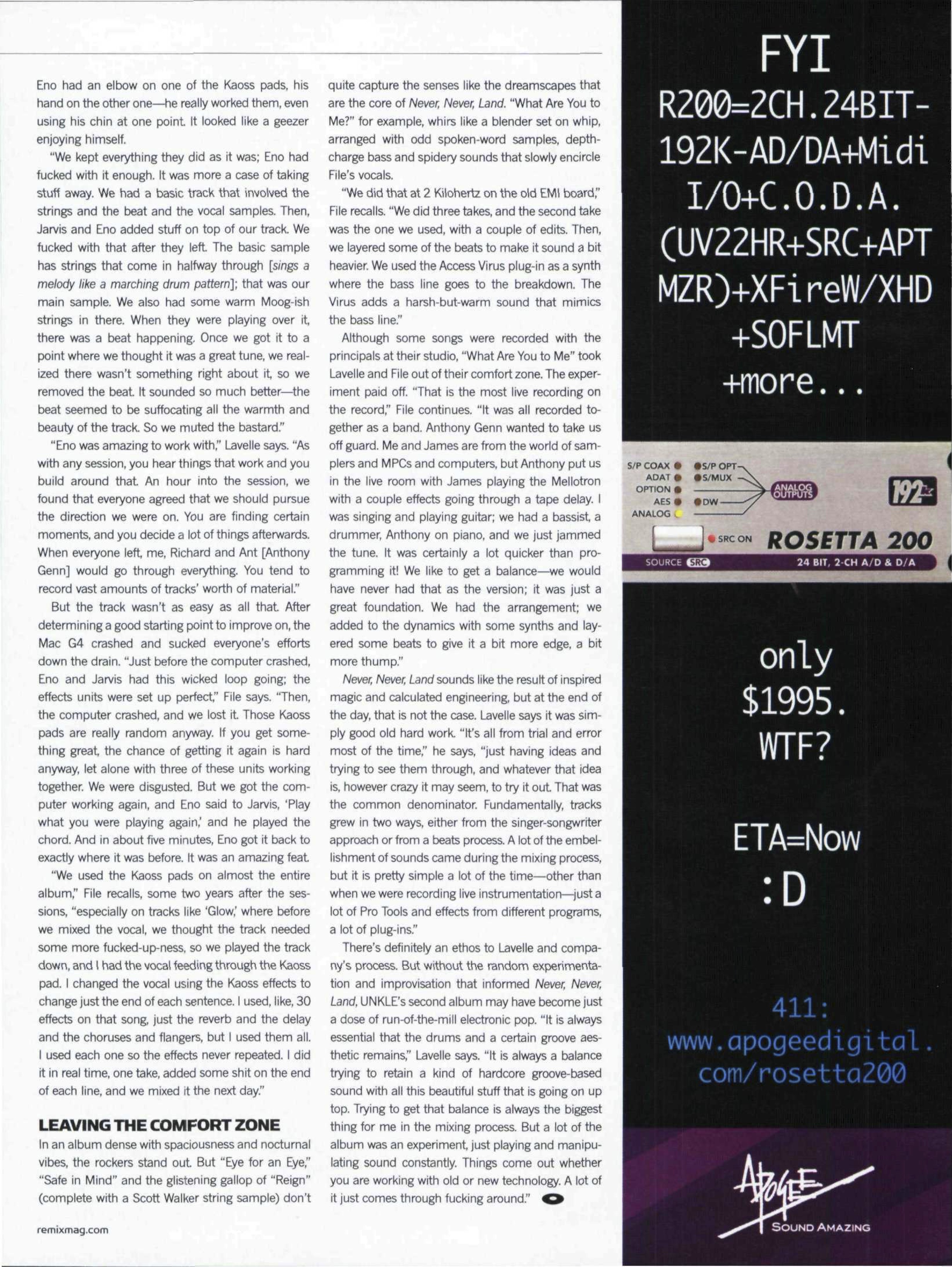Remix November 2004
| Editor | Chris Gill (1999-2003), Kylee Swenson (2003-2009) |
|---|---|
| Categories | Music |
| Frequency | Monthly |
| Publisher | Primedia Business Magazines & Media Inc. |
| First issue | 1999 |
| Final issue | January 2009 |
| Company | Penton Media, Inc. |
| Country | United States |
| Based in | Marion, Ohio |
| Language | English |
| Website | remixmag.com |
James Lavelle and Rich File discuss the latest UNKLE album, Never Never Land in the November 2004 issue of the American edition of Remix Magazine, Vol. 6 Issue 11, pages 34-39.
Transcript
Face it: Sometimes, the only way you can make a mark in the world is to dream big. Just ask James Lavelle. Founder of the Mo'Wax label, whose early Headz compilations ushered in the reigning days of UK trip-hop, Lavelle's ID as a producer had as much to do with his impressive list of contacts as his DJing and mixing skills. But Lavelle was a dreamer, and after helping to establish the careers of DJ Shadow, Howie B, the Ballistic Brothers, Roni Size and others, his next concept was to line up a star-studded cast to do his bidding in a set of heroic trip-hop that had all the grandeur of an Elmer Bernstein soundtrack framed by the black-hearted paranoia of a drug runner's nightmare.
UNKLE'S 1998 debut, Psyence Fiction (Mo'Wax), was a showcase for Lavelle's favorite artists and his ability to bring them in under the umbrella of his dark sonic vision. The album featured contributions from DJ Shadow, Badly Drawn Boy, Beastie Boys' Mike D, Kool G. Rap, former Verve frontman Richard Ashcroft and Radiohead's Thom Yorke. But some six years later, trip-hop is a goner, Mo'Wax is in a state of permanent stasis, and Lavelle's persona as a magical producer lies in jeopardy. Lavelle's former UNKLE collaborator, DJ Shadow, left under reportedly friendly terms, though he told Kool magazine, "I feel like I've graduated; I've learnt my lessons."
Reflecting a changing dance-music culture and a desire for beauty amid the muck and mire, UNKLE's follow-up, Never, Never, Land (Global Underground, 2004), is practically beatless and without quite the same level of star power yet still manages to be a blissful, even romantic, epic that follows Lavelle's obsessed vision while reaching for a universal sense of something greater than itself. Never, Never, Land shows Lavelle, new collaborator Richard File (aka Forme) and multi-instrumentalist/producer Anthony Genn (Elastica, Pulp) creating intricate arrangements that involve performance scenarios ranging from rock bands jamming with lone knob twiddlers to 24-piece orchestras layered under 128-voice Digidesign Pro Tools - enhanced choirs. Like Massive Attack dreaming of Pink Floyd, Never, Never, Land is a gorgeous hallucination that assimilates the promise of Psyence Fiction and takes UNKLE a step further into the unknown.
"I think any artist who is into certain influences is going to have a certain sound," Lavelle explains from a taxi motoring through central London. "That is a positive thing, not a negative thing. Ultimately, it is just about your emotions, and if you are working with different people, it is going to sound different anyway. If you are looking at music more as a soundscape rather than just as a vocal or in a traditional pop sense, then you are always going to create different dynamics, which are going to keep it interesting - in the same way that a band like Radiohead would where a band like Oasis wouldn't. One is very formulaic; one is not. It just depends what you are going for."
BETTER TECHNOLOGY THROUGH HUMANS
Although Never, Never, Land lacks a star of Yorke's stratospheric stature, it does boast several ringers for some unpredictable and amazing results. Recorded at more than 10 London studios - including AIR, 2 Kilohertz, Anthony Genn's Dos Shot and an unnamed facility in Scrubbs Lane - the album's guests merge (and at times disappear) within the music's swirling cosmos. Singer Ian Brown - whose "Be There" from Psyence Fiction went Top 10 in the UK - returns on the first U.S. single, "Reign," with fellow former Stone Roses member Mani on bass. Massive Attack's 3D contributes lethargic vocals to "Invasion"; Brian Eno and Pulp's Jarvis Cocker duel with Moogs and Korg Kaoss Pads on "I Need Something Stronger"; Josh Homme from Queens of the Stone Age supplies snarling vocals on "Safe in Mind"; and singer Joel Cadbury of South informs the lovely ballad "Glow." Throughout, File's acoustic guitar and luminous voice channeled through Lavelle's dark shadows fill the production with angelic flourishes and demonic suspicions. But the essence of the UNKLE sound is simple.
"It just represents what I am into musically," Lavelle says. "I just make records I want to hear. It's what comes out of the relationships and the people you are working with at the time. I suppose there is a beat- and sample-oriented aesthetic that comes with the records and all of the influences I have absorbed in my life, from techno to hip-hop to prog rock to Nirvana to Radiohead. There are emotions and moods that will influence what one is doing."
Another Lavelle influence that has become a popular tool is the movie-soundtrack sample. Psyence Fiction's nervy opulence was enhanced by spoken-word samples from Hearts of Darkness, Star Wars, Twilight Zone, Event Horizon and Blade Runner. Although Never, Never, Land's introductory track, "Back and Forth," features a San Francisco street person lamenting his miserable place in the world, the album also samples The Prophecy and The Thin Red Line in "Eye for Eye," George Lucas' THX 1138 in "I Need Something Stronger" and Jacob's Ladder for "Inside."
"For finding spoken-word samples, it just has to have some emotional content to how I am feeling," Lavelle says. "It can come from just watching the most bland, bullshit movie, but it is always about trying to create a mood and expressing something that you are feeling. I am constantly looking and discovering new things."
THE GEAR IN THE MACHINE
Trainspotting aside, Never, Never, Land is an album of inspired performances and virtuoso arranging and mixing. Allegedly recorded on the same EMI desk (at 2 Kilohertz) used by Pink Floyd on Dark Side of the Moon (EMI, 1973), the album took a million approaches during its two-year recording life.
"Mostly, we used whatever was at hand," File says, nursing a broken leg at his apartment near London Bridge. "Certain days, we had certain bits of gear in the studio, and we had me and James' ideas and samples. We had a lot of live musicians coming in and playing stuff; then, we would fuck with that. We would have an idea and get someone in to play on it. Then we would take what we wanted from that and arrange it. Everything came together as randomly as you can possibly imagine.
"For layering certain beats, we used the E-mu ESI-4000 sampler MIDI'd up to Pro Tools. We used Amp Farm plug-ins on a couple of tracks, such as "Invasion"; those guitars are all through Amp Farm - also, Line 6 plug-ins that replicate the Line 6 pedals. That was the best tape delay we had at the time. There were tracks where we used proper tape delay and a Roland Space Echo, but at times, we needed more control than a tape delay would give us. Tape delay has great sound as the real McCoy, but sometimes we didn't want the sound to be so thick and take up so much space. With a plug-in, the sound is a lot thinner, and sometimes you need that in order for it to sit in the mix properly."
TWISTER-STYLE EXPERIMENTS
After the rocking "Eye for Eye" comes "In a State." Led by File's velvet voice and an acoustic-guitar loop, the song rolls through several changes: a "Tubular Bells" - like piano melody; echoing tom drops; whirring synths; gluey bass; mournful strings; and, eventually, a huge chorus singing monosyllabic tones in a cathedral of worshipfulness.
"After the big string crescendo, there are six different singers, including Graham Gouldman [10cc], Anthony, Joel from South," File says. "We got them to sing each note of the chord; then, we layered them and bounced them all to solid tracks in Pro Tools. Imagine if you are playing a mixing desk as you would a piano, but each note comes up on a fader, and as you bring them up, they create a chord. It is a warm, beautiful sound. We played the SSL mixing desk like you would play an instrument and then recorded that back to Pro Tools. In the end, there are 128 voices."
Lush and cinematic, "I Need Something Stronger" is an ambient call to arms, the sound of a confessional at 4 a.m. or perhaps a lone body drifting through deep space, an eerie collage of disembodied voices, instrumental loops and sound effects. "Jarvis Cocker was playing a Memorymoog through Eno's two Kaoss Pads and an Alesis airFX, which is like a theremin," File says. "It doesn't have a stick; it has a ball that you put your hand over, and it changes the dynamic of the sound. At one point, Eno had an elbow on one of the Kaoss pads, his hand on the other one - he really worked them, even using his chin at one point. It looked like a geezer enjoying himself.
"We kept everything they did as it was; Eno had fucked with it enough. It was more a case of taking stuff away. We had a basic track that involved the strings and the beat and the vocal samples. Then, Jarvis and Eno added stuff on top of our track. We fucked with that after they left. The basic sample has strings that come in halfway through [sings a melody like a marching drum pattern]; that was our main sample. We also had some warm Moog-ish strings in there. When they were playing over it, there was a beat happening. Once we got it to a point where we thought it was a great tune, we realized there wasn't something right about it, so we removed the beat. It sounded so much better - the beat seemed to be suffocating all the warmth and beauty of the track. So we muted the bastard."
"Eno was amazing to work with," Lavelle says. "As with any session, you hear things that work and you build around that. An hour into the session, we found that everyone agreed that we should pursue the direction we were on. You are finding certain moments, and you decide a lot of things afterwards. When everyone left, me, Richard and Ant [Anthony Genn] would go through everything. You tend to record vast amounts of tracks' worth of material."
But the track wasn't as easy as all that. After determining a good starting point to improve on, the Mac G4 crashed and sucked everyone's efforts down the drain. "Just before the computer crashed, Eno and Jarvis had this wicked loop going; the effects units were set up perfect," File says. "Then, the computer crashed, and we lost it. Those Kaoss pads are really random anyway. If you get something great, the chance of getting it again is hard anyway, let alone with three of these units working together. We were disgusted. But we got the computer working again, and Eno said to Jarvis, "Play what you were playing again," and he played the chord. And in about five minutes, Eno got it back to exactly where it was before. It was an amazing feat.
"We used the Kaoss pads on almost the entire album," File recalls, some two years after the sessions, "especially on tracks like "Glow," where before we mixed the vocal, we thought the track needed some more fucked-up-ness, so we played the track down, and I had the vocal feeding through the Kaoss pad. I changed the vocal using the Kaoss effects to change just the end of each sentence. I used, like, 30 effects on that song, just the reverb and the delay and the choruses and flangers, but I used them all. I used each one so the effects never repeated. I did it in real time, one take, added some shit on the end of each line, and we mixed it the next day."
LEAVING THE COMFORT ZONE
In an album dense with spaciousness and nocturnal vibes, the rockers stand out. But "Eye for an Eye," "Safe in Mind" and the glistening gallop of "Reign" (complete with a Scott Walker string sample) don't quite capture the senses like the dreamscapes that are the core of Never, Never, Land. "What Are You to Me?" for example, whirs like a blender set on whip, arranged with odd spoken-word samples, depth-charge bass and spidery sounds that slowly encircle File's vocals.
"We did that at 2 Kilohertz on the old EMI board," File recalls. "We did three takes, and the second take was the one we used, with a couple of edits. Then, we layered some of the beats to make it sound a bit heavier. We used the Access Virus plug-in as a synth where the bass line goes to the breakdown. The Virus adds a harsh-but-warm sound that mimics the bass line."
Although some songs were recorded with the principals at their studio, "What Are You to Me" took Lavelle and File out of their comfort zone. The experiment paid off. "That is the most live recording on the record," File continues. "It was all recorded together as a band. Anthony Genn wanted to take us off guard. Me and James are from the world of samplers and MPCs and computers, but Anthony put us in the live room with James playing the Mellotron with a couple effects going through a tape delay. I was singing and playing guitar; we had a bassist, a drummer, Anthony on piano, and we just jammed the tune. It was certainly a lot quicker than programming it! We like to get a balance - we would have never had that as the version; it was just a great foundation. We had the arrangement; we added to the dynamics with some synths and layered some beats to give it a bit more edge, a bit more thump."
Never, Never, Land sounds like the result of inspired magic and calculated engineering, but at the end of the day, that is not the case. Lavelle says it was simply good old hard work. "It's all from trial and error most of the time," he says, "just having ideas and trying to see them through, and whatever that idea is, however crazy it may seem, to try it out. That was the common denominator. Fundamentally, tracks grew in two ways, either from the singer-songwriter approach or from a beats process. A lot of the embellishment of sounds came during the mixing process, but it is pretty simple a lot of the time - other than when we were recording live instrumentation - just a lot of Pro Tools and effects from different programs, a lot of plug-ins."
There's definitely an ethos to Lavelle and company's process. But without the random experimentation and improvisation that informed Never, Never, Land, UNKLE's second album may have become just a dose of run-of-the-mill electronic pop. "It is always essential that the drums and a certain groove aesthetic remains," Lavelle says. "It is always a balance trying to retain a kind of hardcore groove-based sound with all this beautiful stuff that is going on up top. Trying to get that balance is always the biggest thing for me in the mixing process. But a lot of the album was an experiment, just playing and manipulating sound constantly. Things come out whether you are working with old or new technology. A lot of it just comes through fucking around."
Staples of Never, Never, Land
Computer, DAW, recording hardware:
Apple Mac G4
Digidesign Pro Tools HD
Console:
EMI TG12345
Synths, modules, software, plug-ins, instruments:
Access Virus plug-in
Alesis airFX Digital Effect Instrument
EMS Synthi synth
Gibson Dove acoustic guitar
Korg Kaoss Pad effects unit; MS-20, MS-2000, Triton synths
Line 6 Amp Farm plug-in
Moog Memorymoog, Minimoog synths
Samplers, drum machines:
Akai MPC2000XL sampler/drum machine
E-mu ESI-4000 sampler
Mics, preamps, EQs, compressors, effects:
Roland Space Echo effects unit
UREI 1176 compressor
Shure SM58 mic
Monitors:
KRK Systems M118
Genelec 1037Cs
Yamaha NS10s
Scans
-
Page 34
-
Page 35
-
Page 36
-
Page 38
-
Page 39




